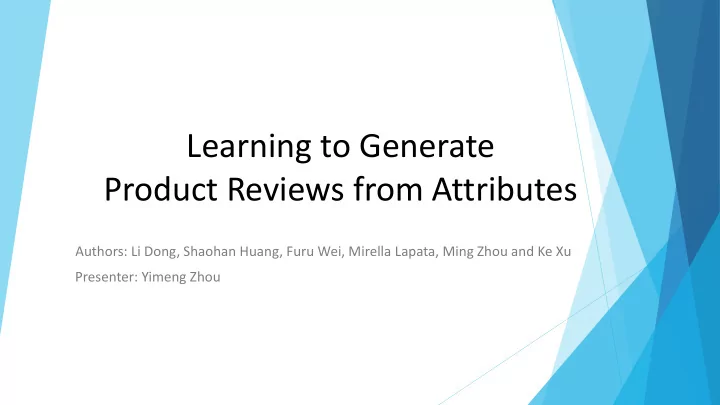

Learning to Generate Product Reviews from Attributes Authors: Li Dong, Shaohan Huang, Furu Wei, Mirella Lapata, Ming Zhou and Ke Xu Presenter: Yimeng Zhou
Introduction � Presents an attention-enhanced attribute-to- sequence model to generate product reviews for given attribute information such as user, product and rating.
Introduction � Challenges: � Variety of candidate reviews that satisfy the input attributes. � Unknown or latent factors that influence the generated reviews, which renders the generation process non-deterministic. � Rating explicitly determine the usage of sentiment words. � User and product implicitly influence word usage.
Compared to Prior work � Most previous work focuses on using rule-based methods or machine learning techniques for sentiment classification, which classifies reviews into different sentiment categories � In contrast, this model is mainly evaluated on the review generation task rather than classification. Moreover, it uses an attention mechanism in encoder-decoder model
Model - Overview � Input attributes � Generate product review to maximize the conditional probability p(r|a) � |a| is fixed to 3 with userID, productid and rating.
Model - Overview � The model learns to compute the likelihood of generated reviews given input attributes. � This conditional probability p(r|a) is decomposed to
Model – Three parts � Attribute Encoder � Sequence Decoder � Attention Mechanism � Att2seq model without attention mechanism
Model – Attribute Encoder � Use multilayer perceptrons to encode input attributes into vector representations that are used as latent factors for generating reviews. � Input attributes a are represented by low-dimensional vectors. The attribute a i ‘s vector g(a i ) is computed via � Where is a parameter matrix and e(a i ) is a one-hot vector representing the presence or absence of a i .
Model – Attribute Encoder � Then these attribute vectors are concatenated and fed into a hidden layer which outputs the encoding vector. The output of the hidden layer is computed as:
Model – Sequence Decoder � The decoder is built by stacking multiple layers of recurrent neural networks with long short-term memory units to better handle long sequences. � RNNs use vectors to represent information for the current time step and recurrently compute the next hidden states.
Model – Sequence Decoder � The LSTM introduces several gates and explicit memory cells to memorize or forget information, which enables networks learn more complicated patterns � The n-dimensional hidden vector in layer l and time step t is computed via
Model – Sequence Decoder � The LSTM unit is given by
Model – Sequence Decoder � Finally, for the vanilla model without using an attention mechanism, the predicted distribution of the t-th output word is:
Model – Attention Mechanism � Better utilize encoder-side information � The attention mechanism learns soft alignments between generated words and attributes, and adaptively computes encoder-side context vectors used to predict the next tokens.
Model – Attention Mechanism
Model – Attention Mechanism � For the t-th time step of the decoder, we compute the attention score of attribute a i via � Z is a normalization term that ensures
Model – Attention Mechanism � Then the attention context vector c t is obtained by which is a weighted sum of attribute vectors.
Model – Attention Mechanism � Further employ the vector to predict the t-th output token as
Model – Attention Mechanism � Aim at maximizing the likelihood of generated reviews given input attributes for the training data. � The optimization problem is to maximize � Avoid overfitting: insert dropout layers between different LSTM layers as suggested in Zaremba et al. (2015).
Experiments � Dataset: built upon Amazon product data including reviews and metadata spanning. � The whole dataset is randomly split into three parts TRAIN, DEV and TEST (70%. 10%, 20%) � Parameter settings: � Dimension of Attributes vectors:64 � Dimension of word embeddings and hidden vectors:512 � Uniform distribution [-0.08,0.08] � Batch size, smoothing constant, learning rate: 50, 0.95, 0.0002 � Dropout rate: 0.2 � Gradient values: [-5, 5]
Results
Results - Polarities
Results – Ablation
Results – Attention Scores
Results – Control Variable
Improvements � Use more fine-grained attributes as the input of our model. � Conditioned on device specification, brand, user’s gender, product description, etc. � Leverage review texts without attributes to improve the sequence decoder.
Conclusion � Proposed a novel product review generation task, in which generated reviews are conditioned on input attributes, � Formulated a neural network based attribute-to- sequence model that uses multilayer perceptrons to encode input attributes and employs recurrent neural networks to generate reviews. � Introduced an attention mechanism to better utilize input attribute information.
Thank you!
Recommend
More recommend